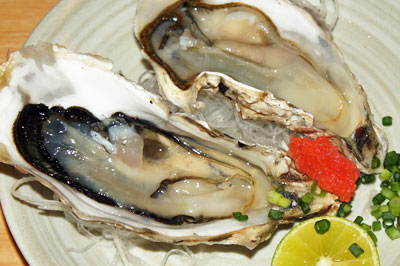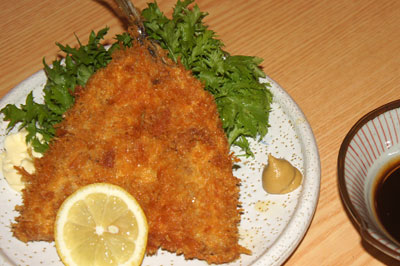- Yummy top
- Eateries and restaurants
- Uoyu - lunch restaurant
- Kanno
- Tokachiya
- Kitchen Nankai - Jinbocho
- Lamb Meat Tender
- Fujiyoshi - tempura restau.
- Enda - Japanese blue crab
- Fukuda - globefish pot
- Sugimoto
- Fuushi
- Soba restaurant
- Shinano - Akabanebashi
- Juwari-soba Inamuraya
- Ando and Korin
- Toranomon Sunaba
- Izakaya
- subLime and Kakinoki
- Donburi-bachi
- Renka
- Yoshida
- Daini-Chikarashuzo
- Sasagin
- Mugiya - soba izakaya
- Fukube
- Sasashin in Ningyo-cho
- Foreign cuisine
- Pizza Piazza
- Atelier de Fromage
- La Piccola Tavola
- Milieu - salad lunch
- Cafe Moskow - Spanish bar
- Sin Tong Kee
- Sekaihanten
- Miscellaneous
- Cheese & champignon party
- Natural Cheese Contest
- Donburi - rice bowl dish
- Home cooking
- Aji no nanban-zuke
- Spaghetti Carbonara
- Curry rice
Yoshida
Hamadayama 2-19-2, Suginami-ku, 168-0065 Tokyo
Tel: 03-3302-0969
Open:
> 18:00-03:00 of the following day (Mon-Fri)
> 18:00-24:00 (Sat)
> Closed (Sun and Holiday)

Samma : Samma is a slim and long fish and this is its upper half. Intestine is not removed when we grill samma and we enjoy its bitter taste.
Yoshida - the best izakaya in my neighborhood

Entrance of Yoshida. It is usual for such a popular izakaya to put unneccesary things just beside the entrance.
 Yoshida is my most favorite izakaya in Hamadayama area. Customers are treated with variety of delicious tidbits and good sake and shochu as well as with warm yet unassuming services. The look of Yoshida is old-fashioned, both outside and inside, which makes me comfortable and a bit nostalgic. So, for me everything is perfect with Yoshida, though it might not be much attractive to young couples who prefer romantic atmosphere to traditional Japanese delicacy.
Yoshida is my most favorite izakaya in Hamadayama area. Customers are treated with variety of delicious tidbits and good sake and shochu as well as with warm yet unassuming services. The look of Yoshida is old-fashioned, both outside and inside, which makes me comfortable and a bit nostalgic. So, for me everything is perfect with Yoshida, though it might not be much attractive to young couples who prefer romantic atmosphere to traditional Japanese delicacy.
The owner of Yoshida, and at the same time its chef and master waiter, is in his mid-forties, and is to my surprise not called Yoshida-san, but Masuda-san, though Yoshida is also a popular family name. The name of the izakaya "Yoshida" comes from the original owner of the place. We can still see an old and half-crumbling signboard of Yoshida from the platform of Hamadayama station, which says that Yoshida is a specialty restaurant of "tempura and eel". Yoshida still offers tempura and eel but it is not specialized in those foods. Masuda-san learned cooking at a traditional Japanese restaurant in the quasi-apprentice system and became the owner-chef of this izakaya about 20 years ago.

The interior of Yoshida seen from the doorway. Such a layout is common. The owner attends customers at counter while cooking and the customers who want to enjoy conversation among themselves sit at table.
 As I now live overseas, I make it a habit to go to Yoshida in the first evening whenever I come back to Tokyo on home leave or business trip, and I did so this evening as well.
As I now live overseas, I make it a habit to go to Yoshida in the first evening whenever I come back to Tokyo on home leave or business trip, and I did so this evening as well.
When we enter Yoshida, we see a counter with seven chairs on the left and three tables with 4 to 5 seats each on the right. So, Yoshida is not big, but it does not appear easy to serve the maximum number of customers with only one person. When I started to frequent Yoshida, Masuda-san’s wife was there and helped him. But, soon thereafter, as she had to take care of their small children, Masuda-san started to work alone, but he manages it without showing much difficulty. Even when the house is full of customers, he takes order, cooks and serves sake and foods quite smoothly.

A part of Kumade: talisman to bring thriving business
This evening, we started with draft beer and boiled spinach. After nearly twenty hours of flight, they were so delicious to me and I forgot to take pictures!

Kuri-sembei

Tougan no nitsuke

Nama-gaki

Zosui

Masuda-san, the owner-chef of Yoshida

Aji furai

Yurine to ebi no kakiage
It is so fun and exciting to choose from the daily offers of tidbits of Yoshida and they are so plenty. Roughly speaking some 40 menu items are handwritten on the blackboard every day. However, some of them just indicate kinds of fish and we can ask Masuda-san how to prepare - raw, simmer, grill and so on. There are also standard menu items which are not on the blackboard. Therefore, the real number of available dishes is much more than 40. So, it is a good idea to consult with Masuda-san and ask him what he recommends us. We can also request him what to cook and how to cook, even though they are not on the menu. Then, he will realize your idea or he might make a counter proposal.
We then chose, following his recommendation, "kuri-sembei". Kuri means chestnut. Sembei is in its original meaning "rice cracker", but here with its figurative meaning something thin and crunchy. "Kuri-sembei" was slightly salty and crispy and fit for dry sake.
"Samma shio-yaki" (grilled pacific saury; see the photo on top of this page) is originally a very cheap and popular home cooking dish in autumn, the best season for samma. Pacific saury is migratory fish and it comes from the north in big groups. So, a piece of samma is usually sold at 80 to 90 cents in this season. As samma spoils quickly, it was not possible to eat samma in raw except for the neighborhood of fishery ports where they are landed. Grilling was therefore the most popular way of eating samma and samma was a very popular kind of fish because of its cheapness. Despite the cheapness, properly grilled samma is really a delicacy and we eat it usually with grated radish and soya sauce.
"Tougan no nitsuke" (Simmered winter melon) is a plain dish, but preferred especially by women and older people. Many foreigners misunderstand that Japanese people are fish eaters and they eat fish a lot like Americans eat steak. In reality, though we used to eat fish more than meat, the volume of fish was and is not so much. We are much more vegetable eaters. In this dish, the sauce was seasoned with small amount of scallop, but its main actor is winter melon. Some green leaves are assorted.
"Nama-gaki" (raw oyster). When we eat raw oysters in Japan, we usually add grated radish mixed with chilly – therefore its color is red – and soya sauce. Instead of lemon, we use our indigenous small citrus fruits called "sudachi".
Then, "aji furai" (deep fried horse mackerel). In Kanto region we usually eat among others two kinds of small and blue-skinned fish, aji and iwashi (sardine). For deep fry, aji is more often used. I love it! It is nutritious and tasty with "sosu". When we say "sosu", it usually mean special kinds of pre-manufactured Worchester sauce. Bull-dog is the most popular brand name in Tokyo area.
"Yurine to ebi no kakiage" (tempura with lily bulb and shrimp). "Kakiage" is a sort of tempura and its ingredients are more than two kinds and cut in small pieces.
Our main dish for the evening was "Nodoguro no nitsuke" (simmered black-throat sea-perch). Nodoguro (black-throat sea-perch) is a white-meat but very fatty fish and highly appreciated in certain regions of Japan. Cooked with lots of soya-sauce and sugar, it tastes heavenly.
"Zosui". It is our habit to end a meal with rice dish. This rice porridge is with egg, shiitake, nori (sea weed) and some green leaves. Soup is the essence of such porridge. It is often the case that sake drinkers do not eat rice, because they drink sake – a rice product – instead of rice. This evening I drank three cups of sake and did not see any need to take more rice!
